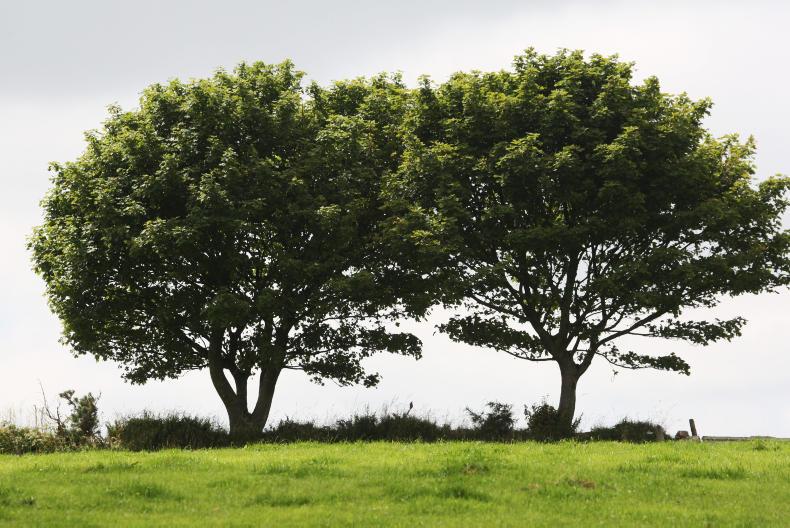Global monocultures conjure up pictures of vast swathes of single-species crops in agriculture and forestry. The Wheat Belt that stretches from Texas in the US to Alberta, Canada, a distance of over 2,400km, is an extreme example of a monoculture in a landscape where individual fields can be larger than 2,000 acres. In forestry, the term refers to large, even-aged, single species, production forests. It is generally applied to man-made forests although large areas of the natural boreal forest can comprise predominantly single species.
The term has resurfaced in Ireland during recent criticism of Irish forest policy. Monoculture has been used directly or by implication to describe forestry development in newsprint articles even by The Irish Times (“Ireland’s native woodlands are quietly disappearing” – 19 June 2018) and The Guardian (“Sitka spruce is marching across the land” – 10 October 2018).
Forest estate
That commercial forests are replacing native woodlands is untrue, which the author of The Irish Times article should have known if he bothered to check National Forestry Inventory data. The area of broadleaved forests – predominantly native – has increased by 27% from 152,000 to 193,500ha (Table 1) from 2006 to 2017.
Broadleaves and the native conifer Scots pine now comprise 25.8% of the forest estate. In addition to the 11% forest cover, Ireland has an additional 5% of the land area covered in hedgerows (4%) and other wooded land (1%), with predominantly native species.
Sitka spruce covers 44.6% of the forest estate but has fallen from 47% since 2006. As for Sitka, “marching across the land” the species will cover less than 5.5% of the land area of Ireland by 2050 if recent afforestation trends are maintained. Sadly, based on recent performance, total forest cover at best will only reach 13% by midcentury which is another issue.
The criteria to achieve a forest monoculture include single species, even age and large area. On this basis, the private forest estate doesn’t even come close to monoculture status. Neither will future forests as all afforestation now require at least 30% broadleaves and/or open areas. The average size of forests is less than 7ha, so scale is not an issue and as a result neither is the creation of an even-aged forest estate.
Nursery production
Forest owners in Ireland have shown that they are prepared to plant broadleaves and for a period before the outbreak of ash dieback, established up to 38% of the planting programme with mainly native species. The disease had a major negative effect on native species afforestation. However, forest owners – mainly farmers – have never lost their desire to plant indigenous species as pointed out by Teige Ryan of None so Hardy Nurseries.
“Over the past nine years, we have supplied 39m broadleaves for the planting programme,” he says. “Our final dispatch figures for the current planting season show broadleaves (3.5m plants) and native Scots pine (210,000 plants) accounting for 32% of the total plants delivered. In addition, 533,000 thorn plants were sold separately to landscapers and directly to farmers for native hedgerow planting.”
Our experience has been that Sitka and Norway spruce in particular have acted as enablers in achieving a viable native species programme
From his discussions with clients, he is confident that the strong demand for broadleaves and the native conifer, will continue due to strong interest in the Department’s Native Woodland Scheme (NWS). He outlines None so Hardy’s seed collection programme and is confident the nursery will meet the demand for diverse species – native and naturalised – as well as the conifer programme. “Our experience has been that Sitka and Norway spruce in particular have acted as enablers in achieving a viable native species programme,” he maintains.
Each autumn we aim to collect three tonnes of thorn berries which after three years in production, should yield over 350,000 saleable plants
“We collect home seed for oak, birch, cherry, rowan, hazel, sycamore, thorn – whitethorn, blackthorn – guelder rose, spindle and crab apple from the summer through to October,” he explains.
“Each autumn we aim to collect three tonnes of thorn berries which after three years in production, should yield over 350,000 saleable plants. We don’t set a limit on oak collection as acorn production varies from year to year but indications are that autumn 2019 will be a good mast year.”
Seed collection is an important employment outlet for the nursery. “ During seed collection, we employ up to 30 staff at a time when otherwise the nursery is quiet, before the lifting season begins,” he says. “Nursery staff collected 13.5t from registered seed stands over the last three autumns.”
The tree species mix demonstrates that “None so Hardy services a forest polyculture rather than a monoculture,” he maintains.






 This is a subscriber-only article
This is a subscriber-only article










SHARING OPTIONS: